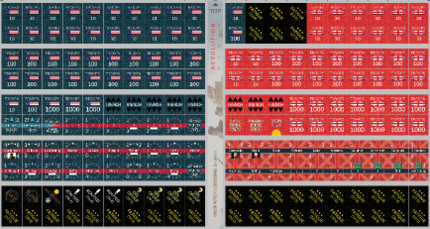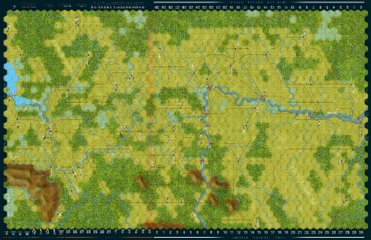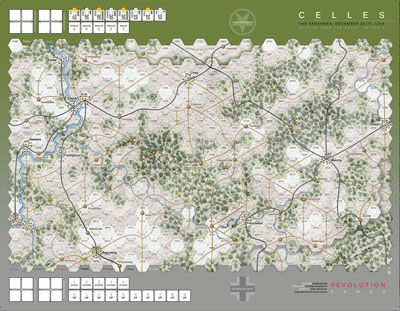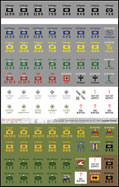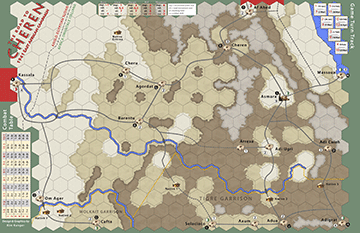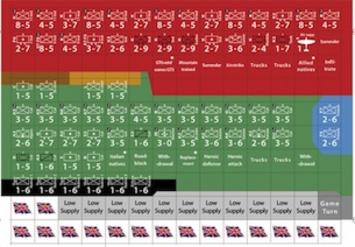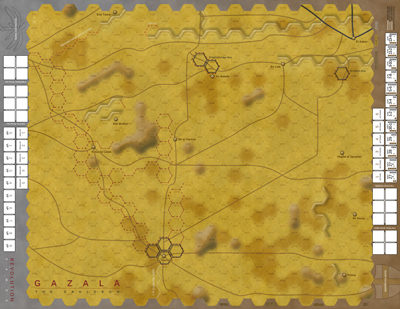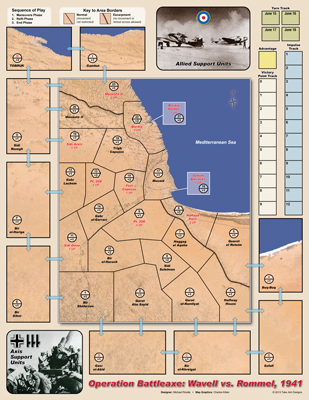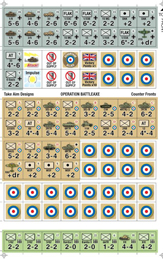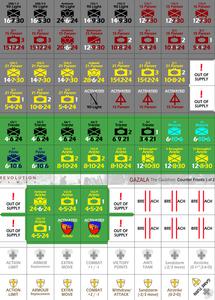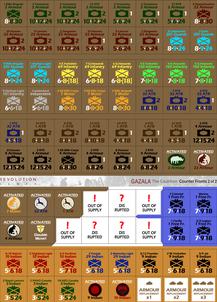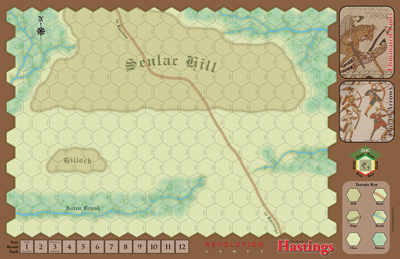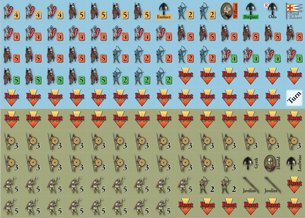By the Staff of Revolution Games
Revolutionary Sale!!
We are discounting all of our games until the end of December. Buy now while supplies last.
Read More Here

All games are produced and assembled in the USA.
Washington’s Crossing is an operational simulation of the American winter campaign of December 25th, 1776 to January 6th, 1777 that resulted in the twin victories of Trenton and Princeton and turned the fortunes of the American Revolution. The situation is fluid and desperate for both sides, allowing for numerous strategies for both players. Victory is determined through both battle victories and occupation of key objectives to simulate the British effort to pacify and restore the loyalty of New Jersey.
Washington’s Crossing is the first game in the Campaigns of the American Revolution series. Future linkable titles in the series will cover the New York campaign of 1776, the Philadelphia campaign of 1777, and the New Jersey campaign of 1778.

Washington’s Crossing
Game Components:
The game consists of the following components:
- 200 die-cut counters
- 2 Player Charts
- 1 Full Color British Leader Display
- 1 Full Color American Leader Display
- 1 Full Color Setup Chart
- 1 22 x 34″ map of New Jersey and Pennsylvania
- 1 10 sided die
- 1 24 Page Rule Booklet
- Game Box
View Counters
View Map
©2012, 2013, 2014 Revolution Games, All Rights Reserved.
Game Designer : Roger Miller
Developer: Richard Handewith
Game Art: Mark Mahaffey

Battles of the Bulge: Celles
Celles is a fast moving simulation of the fighting at the high watermark of the German Ardennes offensive, AKA “The Battle of the Bulge”. The Germans are advancing towards the Meuse River and are running out of fuel and time to force a desperate crossing to achieve Hitler’s goal of ultimate “Victory”. The Allied forces are both trying to block the German advance and begin a counter-offensive to destroy the German Panzer Divisions.
Alternating random activation by formation provides players with uncertainty and excitement. Each turn, players receive a varying number of activations (not all formations may move and some may move more than once!) to represent fuel shortages, aggressive generalship, command uncertainty, and piecemeal reinforcements that provides players with a rich historical feel. After units move, strengths are reduced to simulate fatigue and lack of defensive preparation. This is a game for players who love to counter-attack!
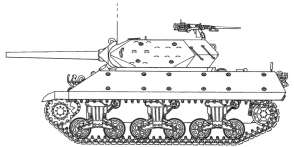
Game Components:
The game consists of the following components:
1 – 22 x 17″ full color map of the battle (3/4″ Hexes)
88 – full color 5/8″ die-cut counters
8 Page Rule Booklet
1 – Player Chart
Ziploc Bag
Game Scale:
Map: 1 Mile per hex
Time: 2 turns per day
Units: 1 to 3 battalions per unit
Turns: 8
Play Time: 3 Hours
Players: 1 or 2
Solitare Suitablity: High
Sample Map and Counters
Click to view larger image
Celles Introduction Part 1
Marco’s Review
Comment on Boardgamegeek: “Best hex and counter wargame I’ve ever played. The activation/spent system is brilliant and makes each move a difficult and challenging choice. The game has a great sense of momentum and keeps me guessing. The simple rules and low number of units reminds me of the Napoleon 20 series from VPG but I like this system more. Can’t wait for future games in this series.” Read the comment here
Boardgamegeek Post: This is a nice little game. The chit pull system works a little differently; instead of having the chits in one cup, each side has its own cup. So, each side will usually be able to do something during a turn. It is also asymmetric, the Germans have the advantage at night, and the Allies have the advantage in the day. The combat and movement system are intertwined, it costs movement points to attack. So, the more movement points you can invest the more effective the attack and you have to plan a bit ahead to get full use out of your units and attacks tend to come in waves. Also, after a unit moves, it is flipped and becomes more vulnerable. Another point I like about the game is that both sides will attack and defend during the game and the German player has several different choices to make in his overall strategy. The two main ones being whether to dash to the Meuse with the 2nd Panzer or try to destroy the 84th infantry or some combination. In any case, every game will be a little different given the chit draws. I forgot to mention that there are two types of chits, one for units which allow you to activate that particular unit or one counter from another unit and tactical chits which will give some benefit when played. This game will stay in my collection and I would probably try other games in the series. In my first game the Germans lost, when they got hung up trying to take Rochefort and then overextended themselves attempting to reach the Meuse. The counterattack by the 2nd Armored was devastating. Read the post here.
What gamers think
The Road to Cheren
The road to Cheren is our new game covering the Eritrea campaign in East Africa in 1941. The campaign featured British and French forces versus the Italians in a wild and mountainous country. The game was designed by Kim Kanger who also designed Ici, c’est la France, Tonkin, and the soon to be released Dien Bien Phu, all by Legion Wargames.
Cheren is a game where the movement of each piece is critical. After movement your opponent may react but with only a few units, making player decisions difficult; do I go to the aid of a unit likely to be attacked or use my reaction to push troops forward in an area where I am on the offensive. After combat there is exploitation movement. Only motorized infantry, tanks and cavalry may exploit and are scarce in this campaign. In addition there is a very nice chit pull system to give both sides some special abilities and keep the enemy guessing as to what comes next. Finally some Italian native units may decide to join the Allies, or they may stay loyal, which creates extra tension in the game.

Sample Map and Counters
Click to view larger image
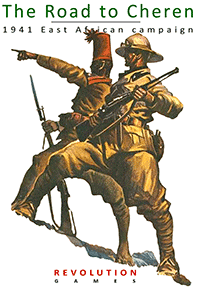
Components:
- 11 x 17″ map
- 113 Die-cut double sided counters
- Eight Page Rule Booklet
- Ziplock Bag
Designed By Kim Kanger
Gazala: The Cauldron

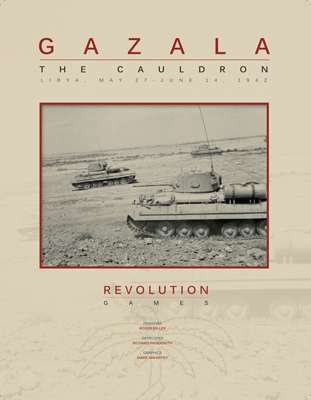
Game Components:
The game consists of the following components:
1 – 22 x 17″ full color map of the battle (3/4″ Hexes)
168- full color 5/8″ die-cut counters
12 Page Rule Booklet
1 – Player Chart
Ziploc Bag
Gazala: The Cauldron simulates the mobile portions of the battle of Gazala south of Tobruk between May 27 and June 14 1942. An Axis attack was met by a furious Allied counter-attack which then developed into a grinding battle of attrition and maneuver that finally ended in massive Axis victory.
Alternating random activation by formation provides player with uncertainty and high re-playability as no two games will be alike. Each turn player receive a varying number of activations to represent the supply levels, command confusion, fatigue and intelligence of their armies and this leads to an ebb and flow to the battle as each side is dominant at different times. After units move, strengths are educed to simulate fatigue and lack of defensive preparation making counter-attacking key to the game. Minefields, airpower, anti-tank abilities and the armor versus infantry conflict are all modeled in a simple and effective set of rules.
There are two scenarios with a playing time of 3-7 hours.
Final Map Art (Click for larger view)
Final Cover Art
Operation Battleaxe: Wavell vs. Rommel, 1941
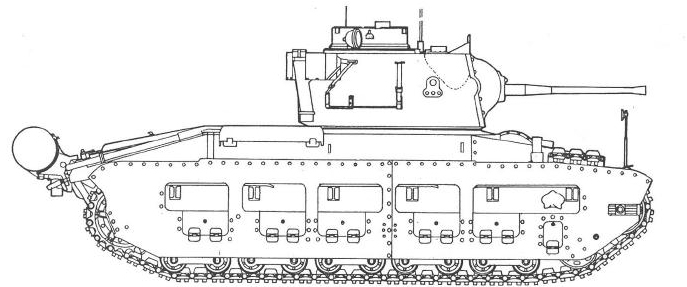
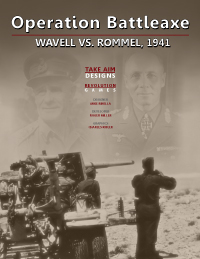
Final Map Art (Click for larger view)
Final Cover Art
Game Components:
The game consists of the following components:
1 – 22 x 17″ full color map
88 – full color 5/8″ die-cut counters
12 Page Rule Booklet
Ziploc Bag
Front Counter Sheet
(Click for larger view)
Operation Battleaxe is a quick-playing depiction of the June 1941 Allied offensive in the North African desert. The Allies possess more tanks, including the “Queen of the Desert,” the Matilda, and have mastery of the air. Crossing the Egyptian border into Libya their mission is simple: destroy the Afrika Korps, and lift the siege of Tobruk! The Axis forces in the path of the Allied advance occupy well-prepared strongpoints, and lurking somewhere behind them are the German panzers – and Rommel, “The Desert Fox.” The next three days of battle will decide the course of the war in the desert for months to come.
Utilizing a new and streamlined version of the “area-impulse” system players will experience the uncertainty of the desert battlefield. Each turn will contain a variable number of impulses, and both players will be challenged to determine whether it is better to attack first, or defend and then counter-attack. Having committed one’s infantry and armor to battle, artillery support may or may not be available. To win the Allied player must exploit his numerical edge in armor and artillery, plus airpower, to capture Axis positions and destroy German units. The Axis player must exploit his greater speed, operational flexibility and superior battlefield recovery, to recover lost ground and destroy Allied units. Fast, furious, and chess-like, this is a game for players who love concentrated action!
New! We have developed an advanced version of the game that introduces a modest increase in complexity while sacrificing none of the original’s excitement! Download the advanced rules here.
Designed by: Mike Rinella
Play Time: 2-3 Hours
Solitaire Suitability: High

$30
$20
Final Counter Art (Click for larger view)
$21
$27
$45
A nice AAR after from one of our customers. Read Here
Marco Reviews Gazala
Errata and Game Updates
- Princetown Scenario (Can be played in under 3 hours)
Marco’s Game Review

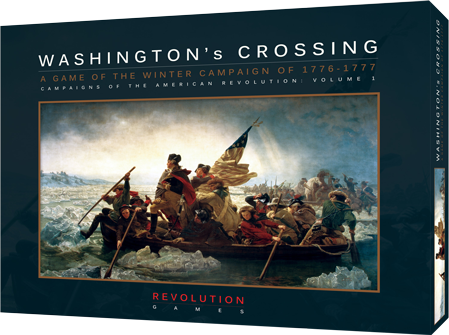
Extras
Updated 3-9-14
Updated 3-9-14
New!
Extras
Game Review by Fred Manzo
New!
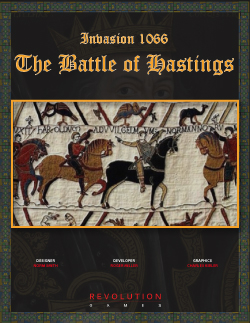

Invasion 1066: The Battle of Hastings
On Sale!!
Final Cover Art
Invasion 1066: The Battle of Hastings is our exciting new game designed by Norm Smith. Originally published as Senlac Hill by Saxon Games, we have enhanced this great design by developing the rule set even further and providing new artwork by industry veteran Charles Kibler.
Can you as William the Conqueror become King of England? Or will Harold deny the invader and keep his throne? Map scale is 50 meters per hex and the units vary in size from 100 to 250 men. The game is quick-playing and bloody with easy to understand mechanics. Historical touches such as cavalry charges, army morale by troop type, leader loss, arrow supply, Saxon javelins, the Papal banner; it is all here in a very easy to play package. The game is available for pre-order now and should ship in late May. Attending Consimworld Expo? We will have the game for sale onsite there at the Revolution Games booth along with all of our other games as well.
The second game in the series Invasion 1066: The battle of Stamford Bridge should be released later this year or early next year. Vikings versus Saxons in a wild wide open game.
Final Map Art (click for larger image)
Components:
11 x 17″ map
140 die-cut counters
12 page rule booklet
2 player aids
ziploc bag
Final Counter art (click for larger image)
The Hastings Battlefield Controversy
Hastings – not just any old hill. There has long been speculation and debate as to exactly where the Battle of Hastings was fought.
- The designers commentary on the controversy
- YouTube link to the T.V. Documentary
- National newspaper coverage (note the legal challenge mentioned in the final paragraph failed.)
- Nick Austin has written extensively on his theory of the Crowhurst site and though not gaining much traction, we thought his work would be of interest. You can view here
- Marc Morris supporting the traditional location of the battle




